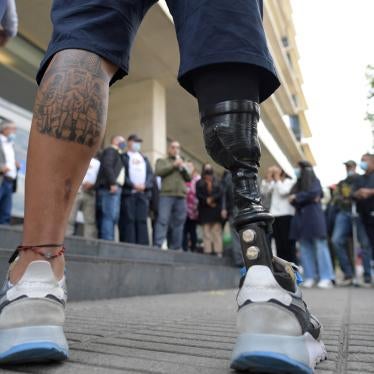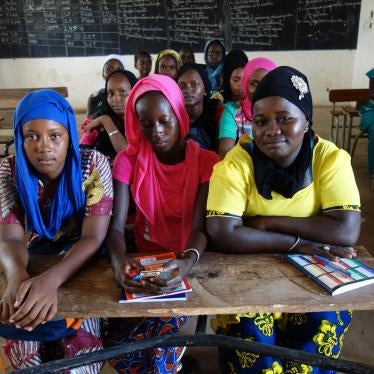Despite the regulations in Protocol III to the Convention on Conventional Weapons (CCW), incendiary weapons continue to cause needless and unacceptable suffering to civilians in conflicts around the world. These weapons produce conscience-shocking injuries to humans and are frequently indiscriminate. Human Rights Watch and the Harvard Law School International Human Rights Clinic call on states to revisit Protocol III. The Fourth Review Conference provides an excellent opportunity to begin this process. In addition to reviewing compliance and universalization, states parties should address the shortcomings of the protocol’s provisions. At the Review Conference, states should speak out about the need for formal discussions on the issue with an eye to adopting a negotiating mandate and ultimately amending the protocol.[1]
What are incendiary weapons, and how are they used?
Incendiary weapons are munitions that produce fire through a chemical reaction. Burns from incendiary weapons cause death, painful injuries, and disfigurement. In modern warfare, these weapons are often used to ignite fuel and ammunition supplies, destroy tanks and other equipment, and attack personnel. Napalm, widely used during the Vietnam War, is the most well known incendiary substance. White phosphorus and thermite are two other common ones.
What kinds of incendiary weapons are most problematic today?
The most problematic incendiary weapons today are those containing white phosphorus. White phosphorus is a chemical substance that ignites when exposed to atmospheric oxygen. The chemical reaction creates intense heat of about 1500° F (815° C) and produces light and a thick smoke. While white phosphorus is frequently used for creating smokescreens, illuminating targets, and marking and signaling, it is also often used to ignite fuel supplies, ammunition, and other materiel. Armed forces have also used white phosphorus to “smoke out” enclosures, causing anyone inside to flee the smoke and fire by going outside where they can be attacked with high explosive rounds. This type of use is controversial, even when applied to enemy combatants, because of the nature of the injuries caused.
Weapons containing white phosphorus raise humanitarian concerns because they produce cruel injuries and often have a broad area effect, which means they cannot be used in a way that discriminates between soldiers and civilians in populated areas. Over the past decade, such weapons have been used in Afghanistan, Gaza, Iraq, Lebanon, and Somalia and have killed and seriously injured many civilians.
What harm does white phosphorus cause to human beings?
Like all incendiary weapons, those with white phosphorus cause death and horrific injuries to humans. White phosphorus in particular is highly soluble in fat, and thus in human flesh. When it comes in contact with skin, it produces severe thermal and chemical burns, often down to the bone, that are slow to heal and likely to develop infections. Because white phosphorus continues to burn if exposed to oxygen, wounds that have been cleaned and dressed can reignite when dressings are removed. White phosphorus can also enter the bloodstream through the burns and cause multiple organ failure. For this reason, burns on only 10 percent of the body are often fatal.
How does CCW Protocol III fail to protect civilians?
As written, Protocol III fails to provide adequate protection for civilians. The definition of “incendiary weapon” in Protocol III is too narrow because it does not clearly cover multi-purpose incendiary munitions. Article 1 of
Protocol III provides a loophole for such munitions in two ways: it encompasses only munitions “primarily designed” to set fires or cause burn injuries, and it provides exceptions for munitions with incendiary effects that are “incidental.” This definition allows multi-purpose, and widely used, incendiary munitions such as white phosphorus to escape regulation. For example, because producers and militaries describe M825E1 155mm artillery projectile rounds as smoke munitions, Protocol III could be read to exclude them from its purview. These rounds have caused harm to civilians when used in or near populated areas.
Furthermore, Article 2’s restrictions on the use of incendiary weapons, however defined, are insufficiently rigorous. They include exceptions that too often permit attacks that could endanger civilians. While the article prohibits attacks in populated areas with air-delivered incendiary weapons, it permits the same kinds of attacks with ground-launched models under certain circumstances.
What kinds of reforms will help to strengthen Protocol III?
The protocol should be amended to address both of the shortcomings just described. First, states parties should replace the overly narrow, design-based definition of “incendiary weapon” with an effects-based definition. The new version should ensure that the protocol covers the most problematic modern incendiary weapons, such as those using white phosphorus.
Second, states parties should bolster the protocol’s restrictions on the use of incendiary weapons. A complete ban would have the most humanitarian benefits. Alternatively, states should at least amend the protocol to prohibit all use of incendiary weapons in populated areas and could require additional precautions in cases where the weapons are used elsewhere. A prohibition on the use of incendiary weapons as antipersonnel weapons, even against military personnel, should also be considered due to the cruelty of the injuries these weapons cause.
[1]For more information, see Human Rights Watch and the Harvard Law School International Human Rights Clinic (IHRC), Memorandum to Convention on Conventional Weapons (CCW) Delegates: The Need to Re-Visit Protocol III on Incendiary Weapons, November 2010, https://www.hrw.org/en/news/2010/11/22/memorandum-ccw-delegates; Human Rights Watch & IHRC, Memorandum to CCW Delegates: The Human Suffering Caused by Incendiary Munitions, March 2011, https://www.hrw.org/news/2011/03/31/human-suffering-caused-incendiary-mun... Human Rights Watch and IHRC, Memorandum to CCW Delegates: Strengthening the Humanitarian Protections of Protocol III on Incendiary Weapons, August 2011, https://www.hrw.org/news/2011/08/22/strengthening-humanitarian-protection....







